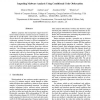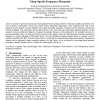848 search results - page 5 / 170 » Understanding Obfuscated Code |
ESORICS
2011
Springer
12 years 7 months ago
2011
Springer
Abstract. Trigger-based code (malicious in many cases, but not necessarily) only executes when specific inputs are received. Symbolic execution has been one of the most powerful t...
NDSS
2008
IEEE
14 years 2 months ago
2008
IEEE
Malware programs that incorporate trigger-based behavior initiate malicious activities based on conditions satisfied only by specific inputs. State-of-the-art malware analyzers ...
CORR
2011
Springer
13 years 2 months ago
2011
Springer
Abstract- In order to prevent detection and evade signature-based scanning methods, which are normally exploited by antivirus softwares, metamorphic viruses use several various obf...
WONS
2012
IEEE
12 years 3 months ago
2012
IEEE
—The IEEE 802.15.4 standard specifies an M-ary spread spectrum system with public and fixed spreading sequences. We propose instead to use secret and dynamic, random spreading ...
WORM
2003
13 years 9 months ago
2003
This paper presents DOME, a host-based technique for detecting several general classes of malicious code in software executables. DOME uses static analysis to identify the locatio...


